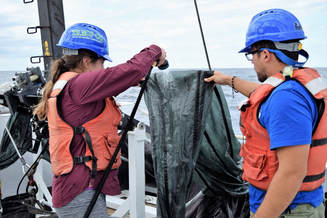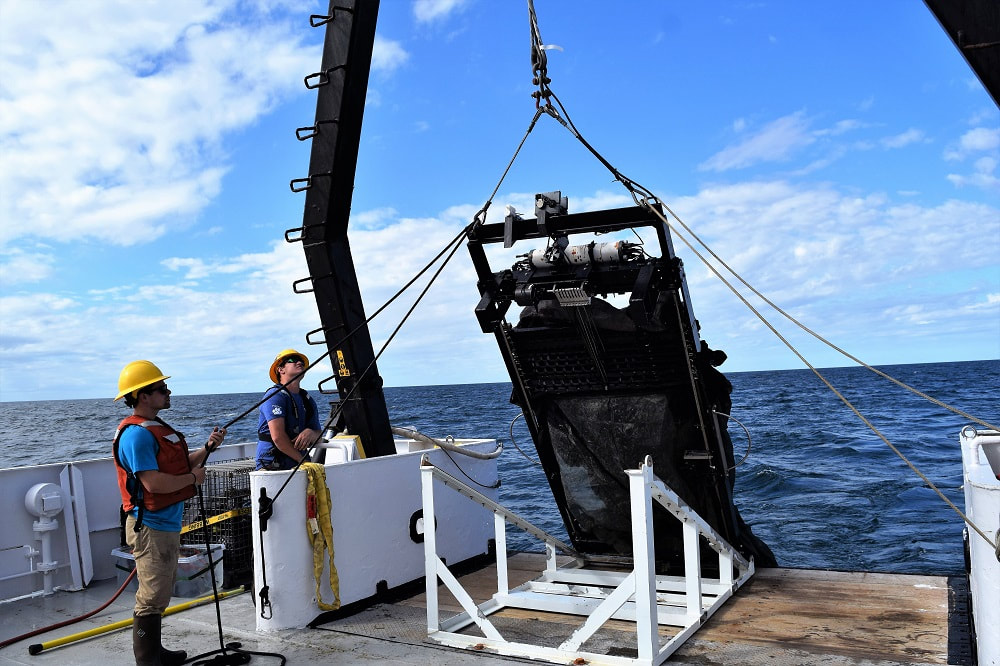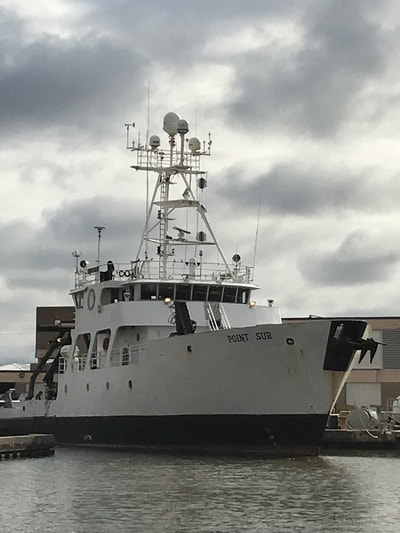 Valeria and Cristian help collect samples from one of the MOCNESS nets (photo by Kate Thompson) Valeria and Cristian help collect samples from one of the MOCNESS nets (photo by Kate Thompson) Posted by Zach Topor, PhD student in Dr. Kelly Robinson's Lab Just like most people, Monday ushered in the start of our work week. However, rather than scooting a chair up to our desks or classrooms, we began our exploration of the ocean blue. A 05:30 wake up is early, even for morning people. But the anticipation of Station 1 motivated me and I sprung (dragged) myself out of bed for breakfast. With full bellies, a beautiful sunrise on the water (my favorite thing), and lots of optimism, our team started the day. We are out in the Gulf of Mexico, off the coast of Texas to see how flood waters from Hurricane Harvey have affected plankton communities, near- and offshore. Plankton, though tiny, have a great impact on all the food webs in the ocean. Everything starts with (or in) the plankton. And that makes it really exciting to study. This cruise is especially important to me because the data and samples that we collect will be contributing to my dissertation research on plankton community ecology. Station 1 marked the beginning of our sampling journey. On this cruise, we are deploying three types of nets to collect zooplankton at each station. Zooplankton are little animals and larvae in the ocean, drifting along in the currents. These include things like krill and copepods, fish larvae, and jellyfish. The net that collects the majority of my samples is called the Multiple Opening/Closing Net and Environmental Sensing System or MOCNESS for short. This system has ten (!) nets with remote controlled openings so that we can discretely sample zooplankton at different depths, all during one tow. With each net, we get a snapshot of the zooplankton community from that specific depth. I am really excited to find out what is happening down there. Even with a few procedural hiccups and some temperamental machinery (all expected on the first day), day 1 was a great success. Day 2 went smoothly (even if the seas weren’t) and our team worked really well together. So far we’ve had beautiful weather, cooperative seas, and a great team effort (not to mention, lots of plankton!!!). And I, for one, am looking forward to the sunrise tomorrow.
1 Comment
Posted by Beth Stauffer, 29 October 2017 In late August, Hurricane Harvey delivered a massive amount of devastating rainfall to Houston and surrounding areas. This water – 33 trillion gallons in total and 24.5 trillion gallons in southeast Texas and southern Louisiana – had to go somewhere. Much of it has been draining into the northwest Gulf of Mexico since then, during a time of year when such freshwater inputs to this system are not typical. Our collaborative team is heading out to this area to study the effects of all this freshwater on plankton in these waters. We are building on data collected just a month before the storm as well as historical datasets from the area to understand how the base of the Gulf of Mexico food web has been affected. Our team consists of members from four research groups based out of three institutions. We are steaming west towards our first station today in relatively comfortable conditions! We will be sampling intensively this coming week, and we will also continue to follow this system in the coming months. Overall, this research will help us build a better understanding of how historic storms like Harvey change our coastal oceans. A bit more about our collaborative team:
Dr. Kelly Robinson is an Assistant Professor of Biology at University of Louisiana at Lafayette. She is a biological oceanographer with expertise in zooplankton, particularly jellyfish. She is interested in understanding how climate change affects what animals are in the plankton and what that means for marine food webs both now and in the future. Zach Topor, a PhD student in the Robinson Lab, is interested in community ecology, especially in the plankton. This is his second oceanographic cruise, and he’s looking forward to 7 to 11 foot seas and seeing the Gulf of Mexico for the first time. Kate Thompson is an undergraduate student researcher. She has a passion for neuroscience and is planning to pursue that in graduate school. This is her first cruise, and she’s hoping to see whales. Dr. Beth Stauffer is an Assistant Professor of Biology at UL Lafayette. She studies the tiny plant-like organisms at the base of marine food webs – phytoplankton – and tries to understand how changes in the species that are present affect the larger animals that depend upon these food webs. Her Masters student Mrun Pathare was part of the GOMECC team that sampled this area in late July, so we're looking forward to seeing how a little time and a lot of freshwater can change things. Gabrielle Corradino is a PhD student working with Dr. Astrid Schnetzer, an Associate Professor of Marine, Earth, & Atmospheric Sciences at NC State University. Dr. Schnetzer’s research focuses on protists (single-called producers and consumers) and zooplankton (primarily copepods and euphausiids), and how natural and man-made processed shape communities and functions of these important organisms. Gabrielle is researching the understudied nanoflagellates as part of her dissertation. She was also part of the GOMECC team who collected samples and ran experiments in these Gulf waters prior to Harvey, and she’s interested to see how the plankton communities have shifted since then. Dr. Simon Geist is an Assistant Professor in Life Sciences at Texas A&M Corpus Christi. His research focuses on ecology, ecophysiology, and interactions of zooplankton with the environment. He’s excited to be doing our first cruise for this project. Dr. Geist has collaborated with the NOAA Southeast Area Monitoring and Assessment Program (SEAMAP) program, an ongoing study on zooplankton abundances that will provide historical context for our findings. Valeria Nuñez is an undergraduate student researcher finishing up her last semester of studies! She wants to combine her love of SCUBA diving, conservation, and education in her future career. This is her first cruise. Cristian Camacho is an undergraduate student researcher. He will be graduating in May, and hopes to get out of Texas for grad school. This is his first cruise, and he’s looking forward to experiencing the offshore life (high seas and all!).  Satellite image of surface chlorophyll in our RAPID study region Satellite image of surface chlorophyll in our RAPID study region The Stauffer Lab is getting ready to head out on the R/V Point Sur on the first of three cruises studying effects of Hurricane Harvey on plankton communities and food webs in the northern Gulf of Mexico. Stay tuned to this page for cruise updates from our collaborative RAPID research team! |
AuthorsMembers of the Stauffer Lab in the Dept. of Biology at UL Lafayette. Check out the byline for specific blog post author information! Archives
March 2018
Categories |
Proudly powered by Weebly






 RSS Feed
RSS Feed